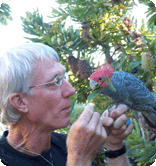Parrot Exercise

Dear EB, I have a Jardines parrot and a Senegal. They are both about 7 months old. My Jardines doesn’t fly as much as my Senegal (don’t know if this is a special issue- I live in a flat). When she does fly around she seems to tire more quickly than my Sennie and pants if they have been going after flying around for a few minutes. The panting only lasts for a few of seconds. My Sennie also pants as well but this is only after going absolutely ballistic. Is this normal and how can I get them to do more exercise.
Regards, Lee

Dear Lee, First of all congratulations for allowing your parrots to retain their wing feathers and fly around!
More and more conscientious pet bird owners are discovering the joy (and convenience) of having flighted psittacines in the home.
It is usual that the larger the parrot, the more it will have to work and hence tire when flying inside a house. This explains why the Jardine’s pants more strongly than the Senegal after flight. Just maneuvering indoors is much more difficult for a larger bird. In an outside or wild situation, the Jardine’s would be flapping briskly and flying very long distances in order to keep fit. This is not possible indoors.
The way I have solved this problem with many of my flighted indoor pets is to trim the first two narrow strong ribbed primary flight feathers at the front of the wing. This effectively cuts down the flight capacity for speed by about 15% depending upon species and athleticism of the parrot; but it does not seriously affect maneuverability. The pet will then begin to flap more exuberantly to accomplish the same flight skills it is used to and will begin getting stronger and making up the 15% difference. The choice can then be made whether to take a third feather or part of the third outermost feather—something we do not always do.
Pay particular attention to the speed and noise of your Jardine’s flight as that will tell you how much effort he or she is expending. As Jardine’s are stocky psittacines, they do need more primaries to get around easily—than say a cockatiel or conure. So it would be most prudent to trim only one of the first two feathers, on both wings the same of course, at a time; then wait a week and do the second.
Also it would be well to take the time to examine your feeding regimen. Most of us overfeed our parrots and keep them 5-10% overweight all the time—especially in the overheating of winter homes. Cut back the fat and heavy carbs in a few food items and replace it with sprouted pulses, fruit pips like pomegranate, melon, papaya, passion fruit, fig, etc. and your bird will trim down accordingly.
Good luck.
Aloha, EB

































